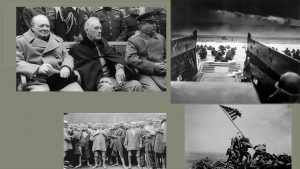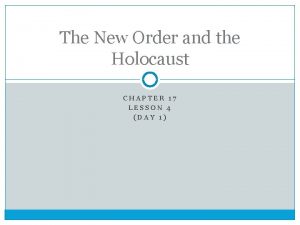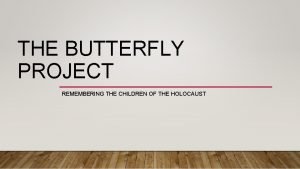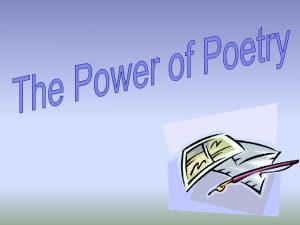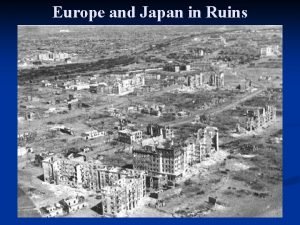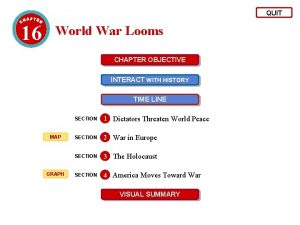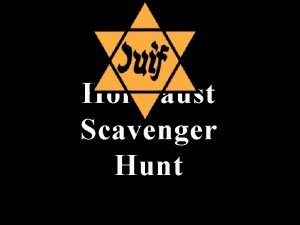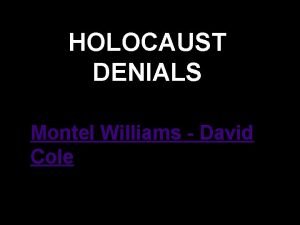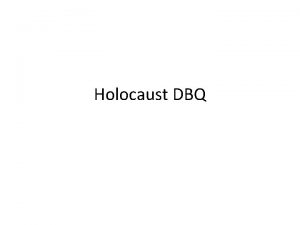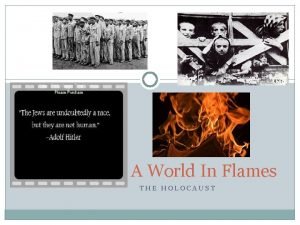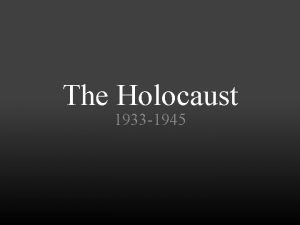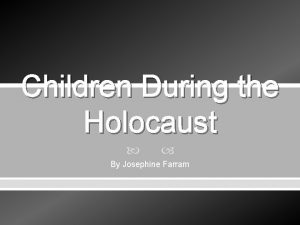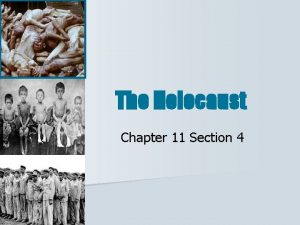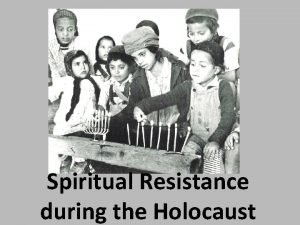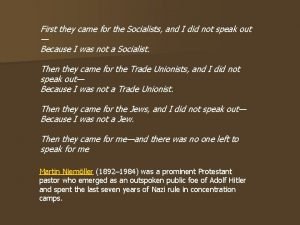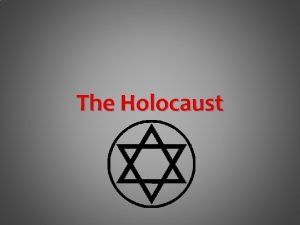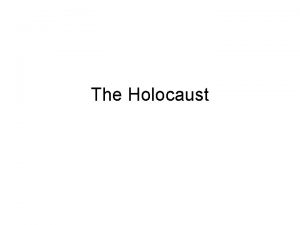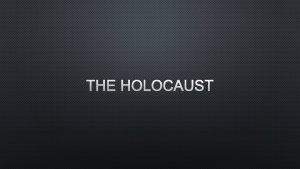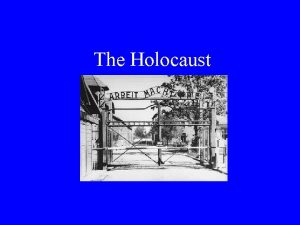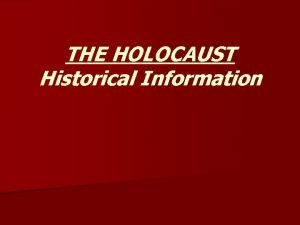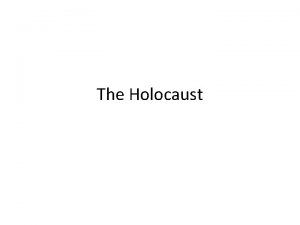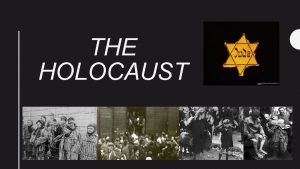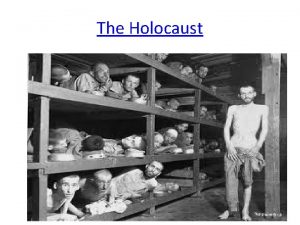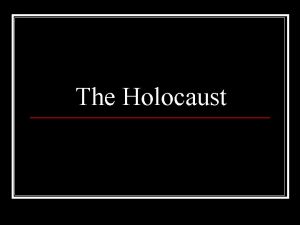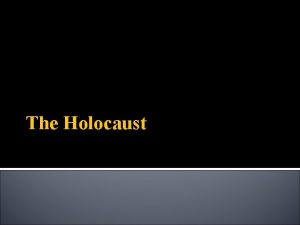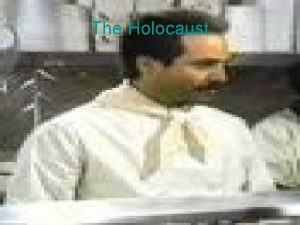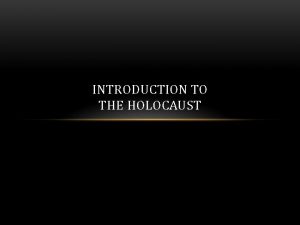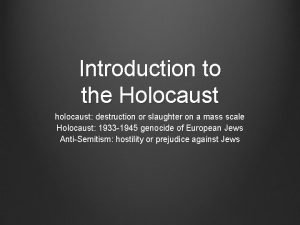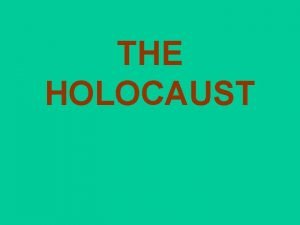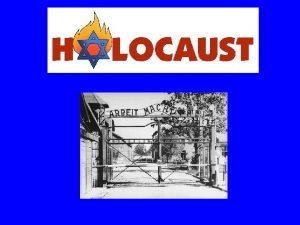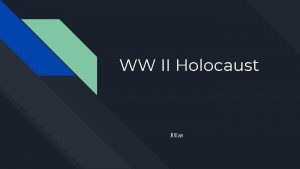Introduction to the Holocaust The Holocaust refers to














































- Slides: 46

Introduction to the Holocaust

• The Holocaust refers to the systematic, bureaucratically planned and industrially perfected murder of six million European Jews. Roma and Sinti, homosexuals and other people that the Nazis deemed “unwanted” or “not worthy of living” were also victims. In an unimaginable extermination program these persons were exploited, tortured, humiliated and murdered in death factories and concentration camps. The deaths were preceded by the propaganda-driven enforcement of a racist, anti. Semitic ideology, the swift repeal of civil rights of the Jews, the appropriation of their belongings, and their confinement to ghettoes. Not only all state organs but also the military elite, industry, banks, academia and the medical professions were directly involved with the Holocaust.

The declarations of war in 1914 were met enthusiastically in Europe. On 6 August, Austria-Hungary declared war on Russia, and young Adolf Hitler celebrated with the rest of Munich on the Odean Platz before he offered his services to the German Army.

In 1919, the victorious allies packed the Hall of Mirrors in Versaiiles. Of the “Big Four” the United States, Italy, France, and England – represented by Woodrow Wilson, Vittorio Orlando, Georges Clemenceau, and David Lloyd George – only Wilson pushed for his own Fourteen Points for a “just peace, ” the reason Germany had agreed to the armistice.

Germany, however, was not invited to the negotiations. Occupied and still blockaded, they were summoned to sign the treaty on 28 June 1919. They protested the ruinous reparations and the degrading Article 231, which blamed them alone for starting the war. The delegation reluctantly signed to alleviate the suffering in Germany. The document became known as “The Versailles Dictate” in Germany.

Temporarily blinded by a British chlorine gas attack in October of 1918, Hitler was still convalescing in hospital when the war ended on 11 November. In Mein Kampf, he recalled, "There followed terrible days and even worse nights - I knew that all was lost. . . in these nights hatred grew in me, hatred for those responsible for this deed. " This feeling, shared by many Germans, led to the formation of the National Socialist German Workers’ Party – Die Nationalsozialistische Deutsche Arbeitspartei (NSDAP) – commonly shortened to Nazi.

In January, 1923, because Germany had defaulted on the punitive reparations imposed by “Die Diktat vom Versailles, ” France occupied the Rhineland to work the industries and mines there for its own benefit. To further humiliate the Germans, the French occupation troops were brought in from its African colonies. The children they fathered became known as the “Rhineland Bastards” and were some of the earliest victims of the Nazis when they were involuntarily sterilized.

The economic crisis that had been growing since the end of the war finally broke in 1923. The hyperinflation in the young Weimar Republic was crippling – savings and investments were wiped out, businesses bankrupted, and unemployment was wide-spread. So was discontent.

By October of 1923, the exchange rate was 6, 250, 000 Reichsmarks to one U. S. penny. It took bushel baskets of mark notes to buy a loaf of bread – when there was any, and the city bakers often had to stretch their limited supplies of flour by adding sawdust. Workers were paid twice a day and threw their pay to their families to buy dinner before prices went up. Communists took over Saxony and Thuringia, and on 17 October riots broke out in Berlin – over the price of bread.

On 8 November 1923, Hitler and General Erich Ludendorff started a revolt in Munich which was designed to spread over the nation and defeat the forces of communism and socialism. It had been planned in a beer hall in that town. The Sturmabteilungen, also known as the SA and the Brown Shirts, made up Hitler’s strike force, and included such party stalwarts as the future head of the Schutzstaffel (SS) and the secret state police, Geheime Staatspolizei (Gestapo), former chicken farmer Heinrich Himmler, at right.

The putsch collapsed the next day after several Nazis died under police gunfire. Defendants Ludendorff and Hitler pose with their supporters including Ernst Roehm, second from the right, the commander of the SA and one of Hitler’s closest friends. A notorious homosexual, he was killed on Hitler’s orders during “Die Nacht dem Langen Messers, ” “The Night of the Long Knives, ” the party blood purge of 30 June 1934.

On 11 November Hitler was arrested and imprisoned in Landsberg Prison. He was given a comfortable cell, as shown below, and had lots of visitors. He was convicted of treason in April of 1924 and sentenced to five years, but was released by December, 1924. During that brief stay he dictated to his secretary, Rudolf Hess (second from the right, below), his political testament, Mein Kampf (My Struggle).

30 January 1933 – Following the Munich Beer Hall Putsch of 1923, Hitler rebuilt the party. After the German Great Depression of 1930, he came to power by the ballot when President Paul von Hindenberg asked him to form a government as chancellor.

27 February 1933 – The German parliament building, the Reichstag, caught fire late at night and was destroyed. Hitler and the Nazis blamed the Communists for the fire. On 23 March, Die Ermächtigungsgesetz, or Enabling Act, was passed, giving Hitler and the Nazis the power to rule by decree and eliminating most civil rights, allowing Hitler to claim that everything he did from then on was entirely legal. Evidence seems to support the conclusion that the fire was started by the Nazis to increase their political power by creating an atmosphere of terror.

Berlin, 5 March 1933

Ochstumsand camp, near Bremen, Germany, 1933, on board a ship, was one of the early “wild” camps for political opponents.

March, 1933 – Dachau, the first concentration camp, opened. Initially it was designed for political prisoners. The motto over the entrance gate, Arbeit macht frei (Work will set you free) was copied over the gates of almost every other camp. Dachau became the training camp for future administrators and personnel of other camps, as well as being a trial site for innovations.

April 1, 1933 – The SA announced and enforced a boycott on Jewish stores. Designed to win international support, the wide-spread public revulsion resulted in it lasting only one day.

“Aryanization” Frankfurt

10 May 1933 – German university students launched an “Action Against the Un. German Spirit” targeting authors ranging from Helen Keller and Ernest Hemingway to Sigmund Freud. In 1821, Heinrich Heine wrote, “Where they burn books, they will end in burning human beings. ”

1 August 1934 – With the death of von Hindenberg, Hitler’s cabinet, pictured here, passed a law abolishing the presidency and proclaiming that all power had transferred to Hitler as Fuhrer und Reichskanzler – leader and Reich chancellor.

The Nuremberg Race Laws (the Reich Citizenship Law and the Law for the Protection of German Blood and Honor), were enacted on September 15, 1935.

8 November 1937 – The traveling exhibit of the anti-semitic “The Eternal Jew, ” to accompany the movie, opened in Munich, based largely on the ficticous Protocols of the Elders of Zion, produced by the tsar’s secret police (Okhrana) to justify the pogroms.

1936 – Jews lost the right to vote; Roma and Sinti were rounded up during the Olympics. 1937 – Passport restrictions were placed on Jews, and a large red J was stamped – at the request of the Swiss. 1938 – Jews lost the right to keep and bear arms, attend plays and concerts, and had to surrender their drivers’ licenses and car registrations. 1939 – Jews were subject to a curfew and had to turn in their radios. Buchenwald Concentration Camp opened in June 1937 as a camp for male political dissidents, but quickly expanded to include the whole gamut of enemies of the Nazis. The next were “habitual criminals” and “asocials, ” including “beggars, tramps, Gypsies, whores, alcoholics with contagious diseases…, ” and homosexuals.

9 November 1938 – Kristallnacht – This was incited by the Nazis after the assassination of Ernst vom Rath in France by Herschel Grynszpan. The Nazis had been waiting for an excuse to begin wide-spread repression of the Jews. This spasm of violence was nation-wide and resulted in the burning of synagogues, the breaking of the windows of Jewishowned stores (which gave the event its name, The Night of Broken Glass), and the round-up of many Jews.

1 June 1939 – The S. S. St. Louis was forced to leave Havana harbor after the Jewish refugees aboard found that their entrance papers would not be honored by the Cuban government. It anchored off Miami Beach, Florida, where FDR ordered the Coast Guard to be sure no one left the ship. They were forced to return to Europe, where many died in the hands of the Germans.

T 4 – October 1939

At Tiergartenstrasse 4 in Berlin, the Nazis began their euthanasia program of “Die Umlebenwurdig, ” “life unworthy of life. ” Using the scientific principles of eugenics the Nazi doctors first eliminated the physically handicapped and then the mentally challenged. The program grew to include other enemies of the party, and when public outrage grew too loud, the project was “stopped. ” In reality it continued even after the surrender and over a wide area. The lessons of the gas chambers were used in the death camps.

A problem for the Nazis was that the Lebensraum they wanted in the east was inhabited by untermenschen – sub-humans, as they were called by the Aryan ubermensch. With the press of military needs, the question was how to economically eliminate them while not wasting the labor. The answer was vernichtigung durch arbeit – destruction through work. In November, 1940, the Krakow Ghetto was sealed off. Inside the ghetto order was kept by the Jewish police controlled by the Judenrat. When labor gangs were led out of the ghetto, they had to wear the yellow Magen David, but not inside, as only Jews were in there anyway. With reduced rations and limited medical supplies, the Nazis let starvation and disease empty the ghettoes – until the final liquidations were to take place.

1941 – This was one Lodz ghetto entrance. Officially a “residential area, ” by 1942 almost 100 factories had been set up in the ghetto to make use of the cheap – and often skilled – labor. Known to the Germans as Litzmannstadt, the head of the Judenrat was the problematic Mordechai Chaim Rumkowski. Deportations to Chelmno happened in 1942, and in May of 1944, as the last Polish ghetto, as well as to labor camps in Germany. The liquidation was completed in August, 1944, by shipment to Auschwitz – Birkenau.

Einsatzgruppen – Mobile killing squads followed the Wehrmacht into the Soviet Union and used different methods to kill Jews, including gas vans, from 1941 to 1943.

January, 1942 – Nazi leaders met in a house in the Berlin suburb of Wansee to discuss Die Endlosung – The Final Solution of the Jewish Question in Europe. The meeting was chaired by Reinhard Heydrich, the Reichs-protektor of Bohemia and Moravia. After he was assassinated in Prague, Aktion Reinhard, named in his honor, began in Treblinka, Belzec, Sobibor, Chelmno, Majdanek, and Birkenau.

Jews were not just victims, though. They fought in resistance movements in France, Poland, the Soviet Union, and Lithuania. The British form the Jewish Brigade.

On 19 April 1943, the Jewish resistance movement in the Warsaw Ghetto revolted in the face of liquidation. The revolt lasted almost a month, with no help from the Poles. It took Waffen-SS soldiers under Major-General Jurgen Stroop to destroy the ghetto. These are some of the photographs that he presented as a birthday present to Hitler with the notice, “The Warsaw Ghetto is no more. ”

2 August 1943 – The Sonderkommando at the death camp of Treblinka revolted and many were able to escape.

14 October 1943 – The Sonderkommando at the death camp of Sobibor revolted. Many who escaped were eventually recaptured, but about 50 remained free and survived the Holocaust.

7 October 1944 – The Sonderkommando at Crematoria IV revolted and dynamited the structure. The revolt spread to Crematoria II before the SS guards put it down. Over 451 prisoners were killed in the fighting and reprisals, with 4, 000 gassed two days later.

April, 1945 – As the forces of the Soviet Union approached the camps in the General Government, Himmler ordered the evacuation and destruction of the camps. In some cases railroad cars were used, and prisoners often rode past columns of German soldiers marching without shoes. For others, movement to Germany meant Death Marches. Taking pictures of these marches was strictly forbidden, yet some risked death to record these images. If a prisoner fell out on the march, at best they were allowed to lie where he or she fell. More often, the prisoner was killed on the spot by bullet or bayonet.

Liberation – Mauthausen, 6 May 1945

29 April 1945 – Dachau was liberated on the same day as Ravensbruck. Mauthhausen, in Austria, was liberated in May. Other camps had been liberated earlier, and for many soldiers it was their first indication that such atrocities had been committed.

Generals Dwight D. Eisenhower, Omar Bradley, and George S. Patton, Jr. , viewed a makeshift crematorium made from a truck chassis at the Ohrdruf camp on 12 April 1945. They did this to be eye-witnesses to insure that no one in the future would doubt that this had happened.




The defendant’s dock at the Nuremberg War Crime Trials. From 20 November 1945 to 1 October 1946, the International Military Tribunal, consisting of the United States, England, France, and the Soviet Union, tried the twenty-four shown above. On 16 October, eleven were executed by hanging. Their bodies were taken to the Dachau concentration camp and were cremated in the ovens there. Nazi war criminals are still being sought and are being prosecuted to this day.

Displaced persons (DP’s) camps existed from 1945 to 1951, often in former concentration camps, although most camps were so vermin infested that they had to be burned down to contain the contagion. Far more people were left homeless, stateless, and without family than had died, and the effort to reunite family survivors continues.
 Totalitarianism
Totalitarianism Lesson 4 the new order and the holocaust
Lesson 4 the new order and the holocaust I never saw another butterfly project
I never saw another butterfly project Alliteration acrostic poem
Alliteration acrostic poem Acrostic poem for holocaust
Acrostic poem for holocaust One way the allies dealt with the holocaust
One way the allies dealt with the holocaust David bergman holocaust
David bergman holocaust Chapter 16 world war looms answer key
Chapter 16 world war looms answer key Upstanders and bystanders during the holocaust
Upstanders and bystanders during the holocaust Holocaust scavenger hunt
Holocaust scavenger hunt David cole holocaust
David cole holocaust Holocaust definition ap world history
Holocaust definition ap world history Guidelines for teaching about the holocaust
Guidelines for teaching about the holocaust Holocaust acrostic poem answers
Holocaust acrostic poem answers Acrostic poem structure
Acrostic poem structure Holocaust acrostic poem answers
Holocaust acrostic poem answers Holocaust hungary
Holocaust hungary Holocaust
Holocaust Holocaust
Holocaust Holocaust
Holocaust How did the holocaust develop and what were its results
How did the holocaust develop and what were its results Holocaust
Holocaust And then they came for me
And then they came for me Hát kết hợp bộ gõ cơ thể
Hát kết hợp bộ gõ cơ thể Frameset trong html5
Frameset trong html5 Bổ thể
Bổ thể Tỉ lệ cơ thể trẻ em
Tỉ lệ cơ thể trẻ em Chó sói
Chó sói Chụp tư thế worms-breton
Chụp tư thế worms-breton Hát lên người ơi
Hát lên người ơi Các môn thể thao bắt đầu bằng tiếng nhảy
Các môn thể thao bắt đầu bằng tiếng nhảy Thế nào là hệ số cao nhất
Thế nào là hệ số cao nhất Các châu lục và đại dương trên thế giới
Các châu lục và đại dương trên thế giới Công thức tính độ biến thiên đông lượng
Công thức tính độ biến thiên đông lượng Trời xanh đây là của chúng ta thể thơ
Trời xanh đây là của chúng ta thể thơ Mật thư anh em như thể tay chân
Mật thư anh em như thể tay chân Làm thế nào để 102-1=99
Làm thế nào để 102-1=99 Phản ứng thế ankan
Phản ứng thế ankan Các châu lục và đại dương trên thế giới
Các châu lục và đại dương trên thế giới Thể thơ truyền thống
Thể thơ truyền thống Quá trình desamine hóa có thể tạo ra
Quá trình desamine hóa có thể tạo ra Một số thể thơ truyền thống
Một số thể thơ truyền thống Bàn tay mà dây bẩn
Bàn tay mà dây bẩn Vẽ hình chiếu vuông góc của vật thể sau
Vẽ hình chiếu vuông góc của vật thể sau Nguyên nhân của sự mỏi cơ sinh 8
Nguyên nhân của sự mỏi cơ sinh 8 đặc điểm cơ thể của người tối cổ
đặc điểm cơ thể của người tối cổ Thế nào là giọng cùng tên
Thế nào là giọng cùng tên
